Arden University COM0006NFBNM: Technology in Organisation Report
VerifiedAdded on 2022/12/09
|13
|3696
|289
Report
AI Summary
This report provides a detailed analysis of technology's role in modern organizations, focusing on big data, IT security, and cellular networks, within the context of Arden University. The report begins by defining technology and its impact on business operations, highlighting the importance of data and information systems. It explores the concept of big data, its structured, unstructured, and semi-structured forms, and its applications within educational institutions, specifically Arden University, including enhancing student results, improving grading systems, and supporting various administrative and marketing functions. The report then delves into IT security and data privacy measures, emphasizing the importance of protecting computer systems and data from unauthorized access and cyber threats. It outlines organizational measures such as information risk assessment and security policies, and discusses the key provisions of the General Data Protection Regulation (GDPR). Finally, the report examines cellular networks, their components, and their significance in modern telecommunications. The report concludes by emphasizing the importance of technology for organizational growth and efficiency, and for ensuring compliance with data protection regulations.
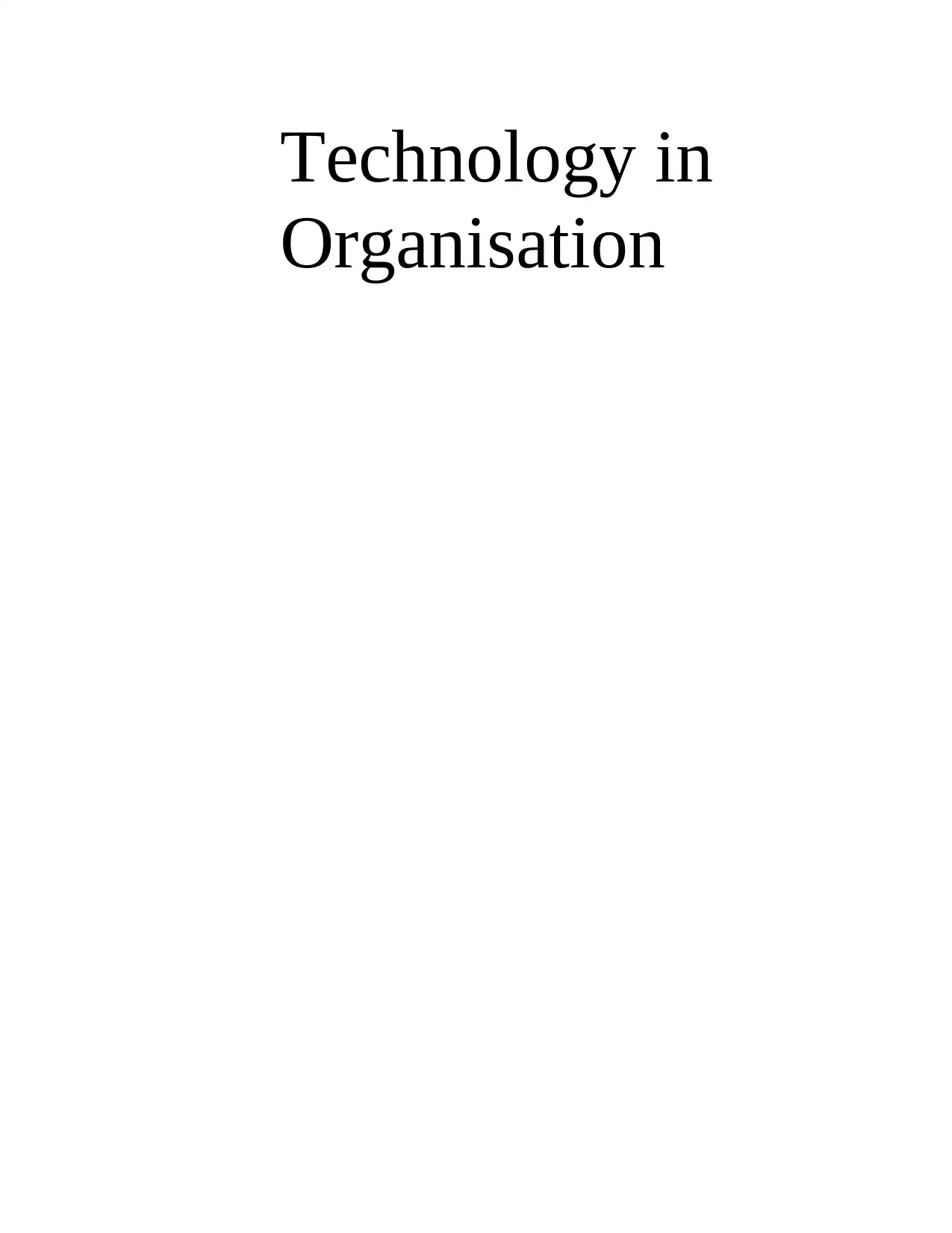
Technology in
Organisation
Organisation
Paraphrase This Document
Need a fresh take? Get an instant paraphrase of this document with our AI Paraphraser
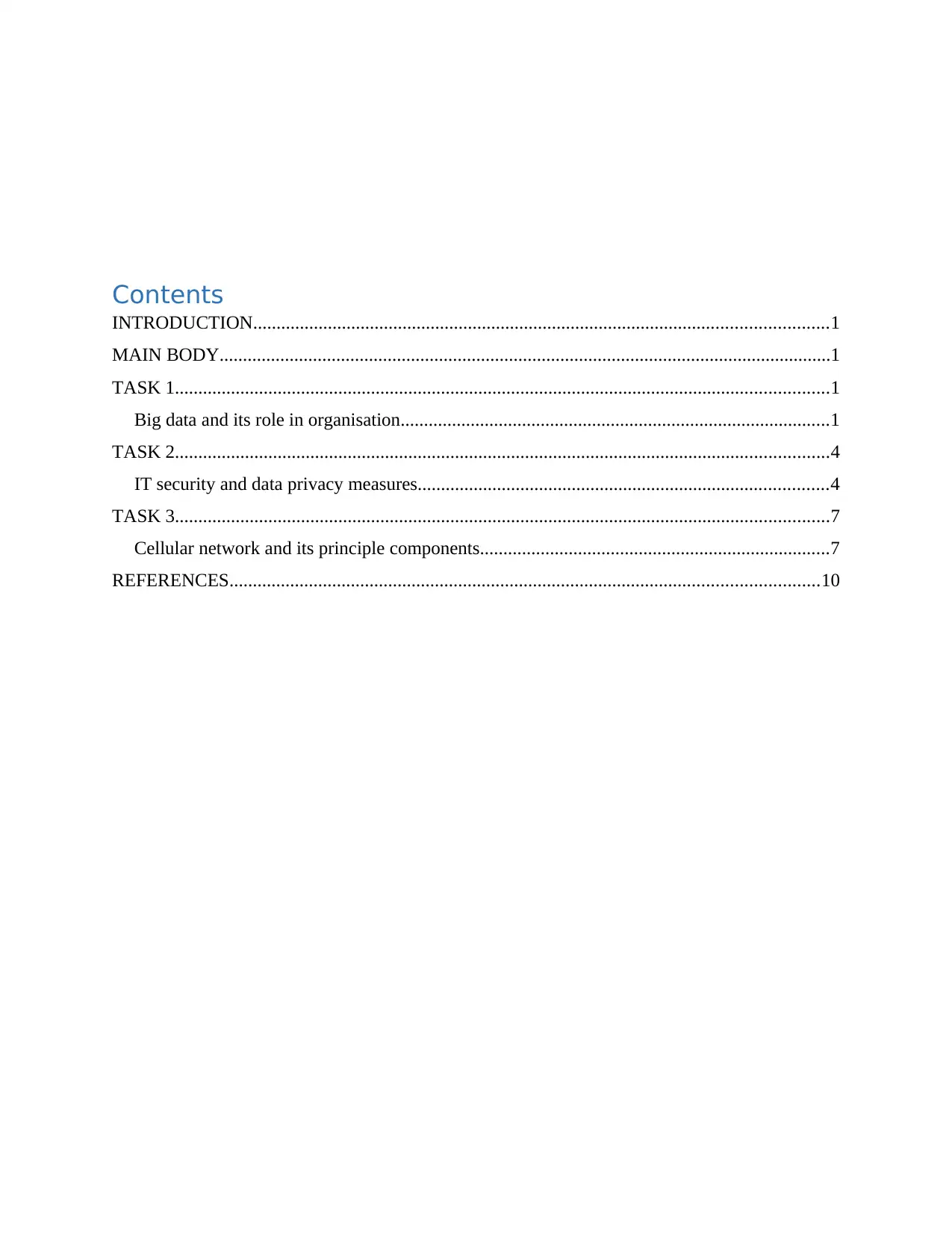
Contents
INTRODUCTION...........................................................................................................................1
MAIN BODY...................................................................................................................................1
TASK 1............................................................................................................................................1
Big data and its role in organisation............................................................................................1
TASK 2............................................................................................................................................4
IT security and data privacy measures........................................................................................4
TASK 3............................................................................................................................................7
Cellular network and its principle components...........................................................................7
REFERENCES..............................................................................................................................10
INTRODUCTION...........................................................................................................................1
MAIN BODY...................................................................................................................................1
TASK 1............................................................................................................................................1
Big data and its role in organisation............................................................................................1
TASK 2............................................................................................................................................4
IT security and data privacy measures........................................................................................4
TASK 3............................................................................................................................................7
Cellular network and its principle components...........................................................................7
REFERENCES..............................................................................................................................10
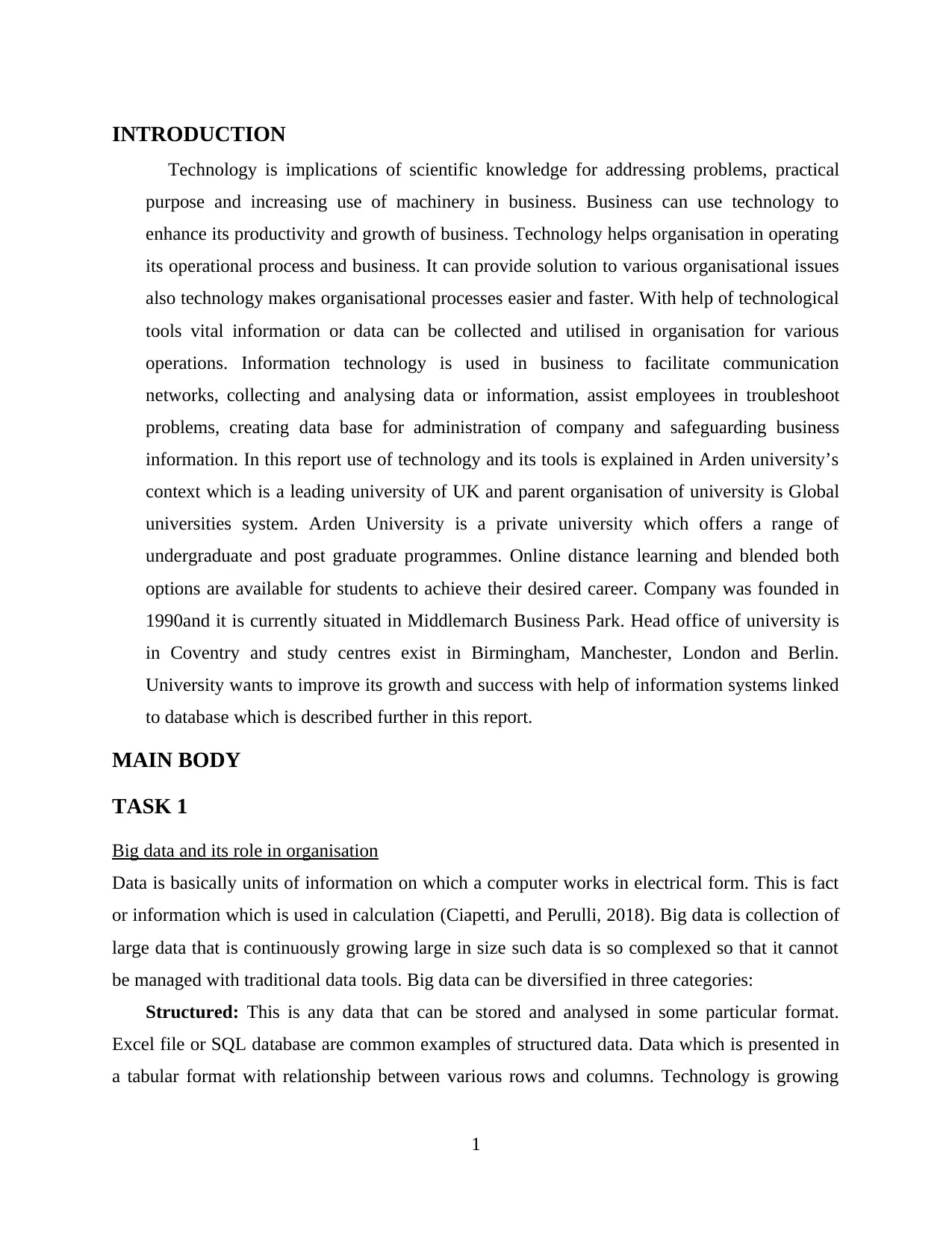
INTRODUCTION
Technology is implications of scientific knowledge for addressing problems, practical
purpose and increasing use of machinery in business. Business can use technology to
enhance its productivity and growth of business. Technology helps organisation in operating
its operational process and business. It can provide solution to various organisational issues
also technology makes organisational processes easier and faster. With help of technological
tools vital information or data can be collected and utilised in organisation for various
operations. Information technology is used in business to facilitate communication
networks, collecting and analysing data or information, assist employees in troubleshoot
problems, creating data base for administration of company and safeguarding business
information. In this report use of technology and its tools is explained in Arden university’s
context which is a leading university of UK and parent organisation of university is Global
universities system. Arden University is a private university which offers a range of
undergraduate and post graduate programmes. Online distance learning and blended both
options are available for students to achieve their desired career. Company was founded in
1990and it is currently situated in Middlemarch Business Park. Head office of university is
in Coventry and study centres exist in Birmingham, Manchester, London and Berlin.
University wants to improve its growth and success with help of information systems linked
to database which is described further in this report.
MAIN BODY
TASK 1
Big data and its role in organisation
Data is basically units of information on which a computer works in electrical form. This is fact
or information which is used in calculation (Ciapetti, and Perulli, 2018). Big data is collection of
large data that is continuously growing large in size such data is so complexed so that it cannot
be managed with traditional data tools. Big data can be diversified in three categories:
Structured: This is any data that can be stored and analysed in some particular format.
Excel file or SQL database are common examples of structured data. Data which is presented in
a tabular format with relationship between various rows and columns. Technology is growing
1
Technology is implications of scientific knowledge for addressing problems, practical
purpose and increasing use of machinery in business. Business can use technology to
enhance its productivity and growth of business. Technology helps organisation in operating
its operational process and business. It can provide solution to various organisational issues
also technology makes organisational processes easier and faster. With help of technological
tools vital information or data can be collected and utilised in organisation for various
operations. Information technology is used in business to facilitate communication
networks, collecting and analysing data or information, assist employees in troubleshoot
problems, creating data base for administration of company and safeguarding business
information. In this report use of technology and its tools is explained in Arden university’s
context which is a leading university of UK and parent organisation of university is Global
universities system. Arden University is a private university which offers a range of
undergraduate and post graduate programmes. Online distance learning and blended both
options are available for students to achieve their desired career. Company was founded in
1990and it is currently situated in Middlemarch Business Park. Head office of university is
in Coventry and study centres exist in Birmingham, Manchester, London and Berlin.
University wants to improve its growth and success with help of information systems linked
to database which is described further in this report.
MAIN BODY
TASK 1
Big data and its role in organisation
Data is basically units of information on which a computer works in electrical form. This is fact
or information which is used in calculation (Ciapetti, and Perulli, 2018). Big data is collection of
large data that is continuously growing large in size such data is so complexed so that it cannot
be managed with traditional data tools. Big data can be diversified in three categories:
Structured: This is any data that can be stored and analysed in some particular format.
Excel file or SQL database are common examples of structured data. Data which is presented in
a tabular format with relationship between various rows and columns. Technology is growing
1
⊘ This is a preview!⊘
Do you want full access?
Subscribe today to unlock all pages.

Trusted by 1+ million students worldwide
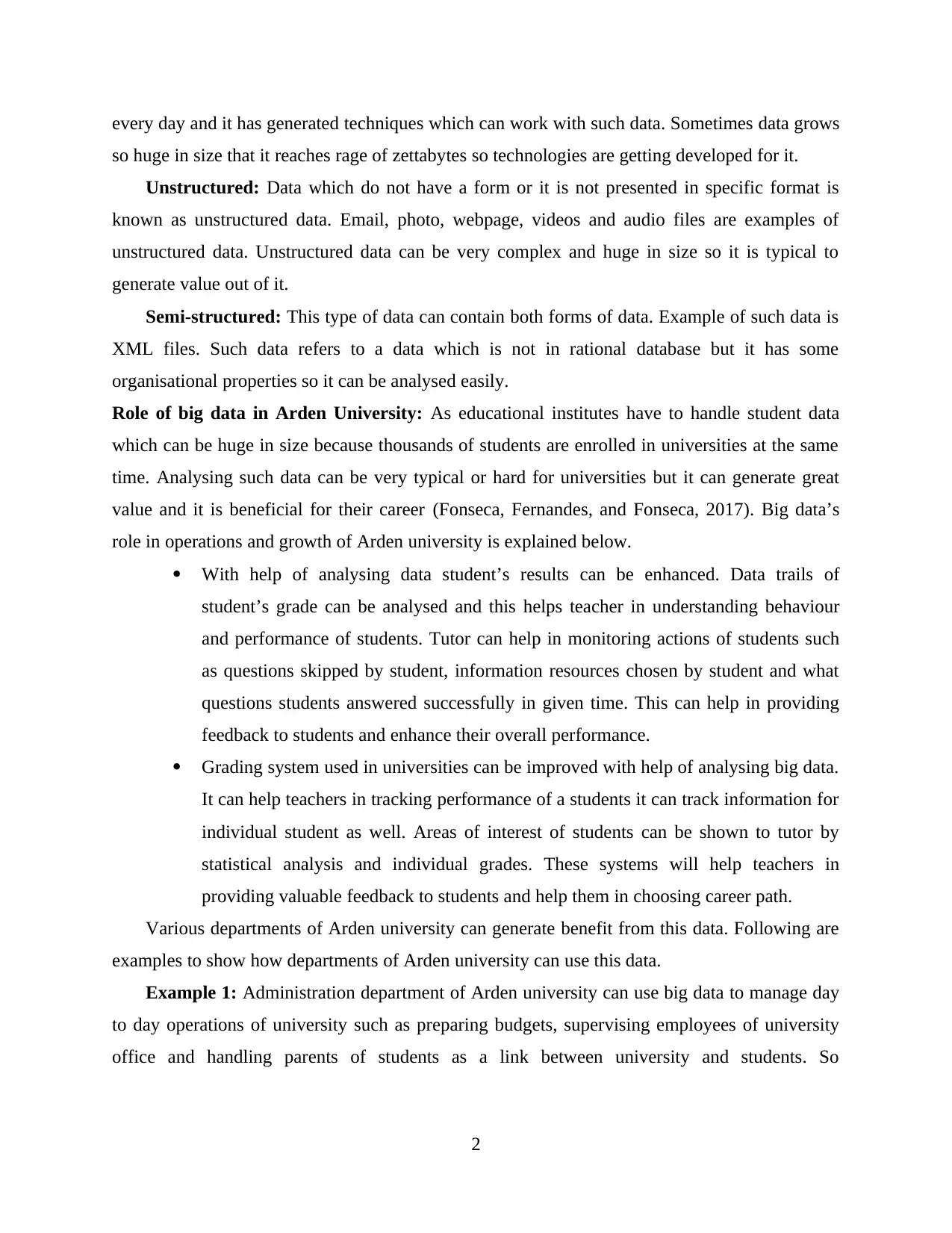
every day and it has generated techniques which can work with such data. Sometimes data grows
so huge in size that it reaches rage of zettabytes so technologies are getting developed for it.
Unstructured: Data which do not have a form or it is not presented in specific format is
known as unstructured data. Email, photo, webpage, videos and audio files are examples of
unstructured data. Unstructured data can be very complex and huge in size so it is typical to
generate value out of it.
Semi-structured: This type of data can contain both forms of data. Example of such data is
XML files. Such data refers to a data which is not in rational database but it has some
organisational properties so it can be analysed easily.
Role of big data in Arden University: As educational institutes have to handle student data
which can be huge in size because thousands of students are enrolled in universities at the same
time. Analysing such data can be very typical or hard for universities but it can generate great
value and it is beneficial for their career (Fonseca, Fernandes, and Fonseca, 2017). Big data’s
role in operations and growth of Arden university is explained below.
With help of analysing data student’s results can be enhanced. Data trails of
student’s grade can be analysed and this helps teacher in understanding behaviour
and performance of students. Tutor can help in monitoring actions of students such
as questions skipped by student, information resources chosen by student and what
questions students answered successfully in given time. This can help in providing
feedback to students and enhance their overall performance.
Grading system used in universities can be improved with help of analysing big data.
It can help teachers in tracking performance of a students it can track information for
individual student as well. Areas of interest of students can be shown to tutor by
statistical analysis and individual grades. These systems will help teachers in
providing valuable feedback to students and help them in choosing career path.
Various departments of Arden university can generate benefit from this data. Following are
examples to show how departments of Arden university can use this data.
Example 1: Administration department of Arden university can use big data to manage day
to day operations of university such as preparing budgets, supervising employees of university
office and handling parents of students as a link between university and students. So
2
so huge in size that it reaches rage of zettabytes so technologies are getting developed for it.
Unstructured: Data which do not have a form or it is not presented in specific format is
known as unstructured data. Email, photo, webpage, videos and audio files are examples of
unstructured data. Unstructured data can be very complex and huge in size so it is typical to
generate value out of it.
Semi-structured: This type of data can contain both forms of data. Example of such data is
XML files. Such data refers to a data which is not in rational database but it has some
organisational properties so it can be analysed easily.
Role of big data in Arden University: As educational institutes have to handle student data
which can be huge in size because thousands of students are enrolled in universities at the same
time. Analysing such data can be very typical or hard for universities but it can generate great
value and it is beneficial for their career (Fonseca, Fernandes, and Fonseca, 2017). Big data’s
role in operations and growth of Arden university is explained below.
With help of analysing data student’s results can be enhanced. Data trails of
student’s grade can be analysed and this helps teacher in understanding behaviour
and performance of students. Tutor can help in monitoring actions of students such
as questions skipped by student, information resources chosen by student and what
questions students answered successfully in given time. This can help in providing
feedback to students and enhance their overall performance.
Grading system used in universities can be improved with help of analysing big data.
It can help teachers in tracking performance of a students it can track information for
individual student as well. Areas of interest of students can be shown to tutor by
statistical analysis and individual grades. These systems will help teachers in
providing valuable feedback to students and help them in choosing career path.
Various departments of Arden university can generate benefit from this data. Following are
examples to show how departments of Arden university can use this data.
Example 1: Administration department of Arden university can use big data to manage day
to day operations of university such as preparing budgets, supervising employees of university
office and handling parents of students as a link between university and students. So
2
Paraphrase This Document
Need a fresh take? Get an instant paraphrase of this document with our AI Paraphraser
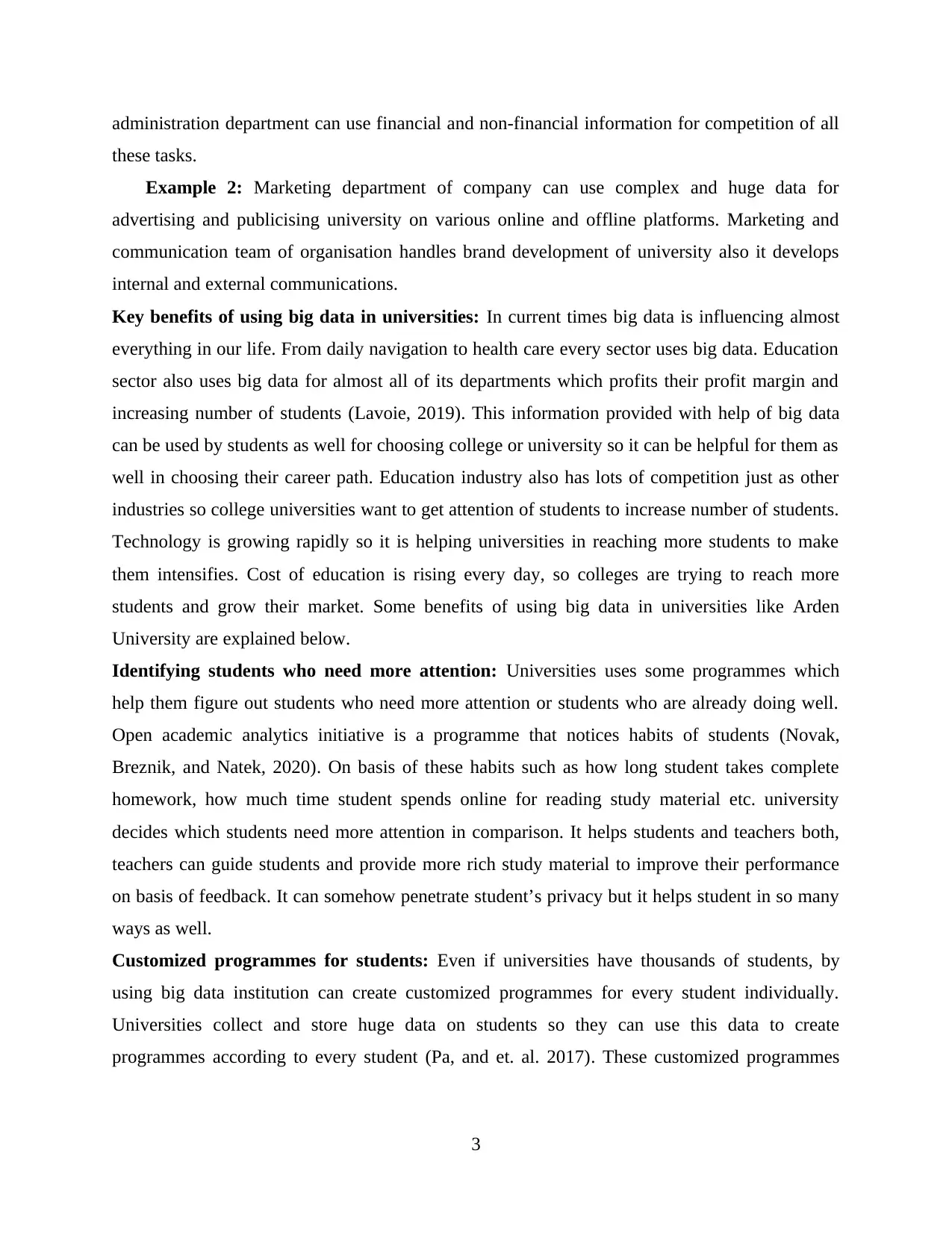
administration department can use financial and non-financial information for competition of all
these tasks.
Example 2: Marketing department of company can use complex and huge data for
advertising and publicising university on various online and offline platforms. Marketing and
communication team of organisation handles brand development of university also it develops
internal and external communications.
Key benefits of using big data in universities: In current times big data is influencing almost
everything in our life. From daily navigation to health care every sector uses big data. Education
sector also uses big data for almost all of its departments which profits their profit margin and
increasing number of students (Lavoie, 2019). This information provided with help of big data
can be used by students as well for choosing college or university so it can be helpful for them as
well in choosing their career path. Education industry also has lots of competition just as other
industries so college universities want to get attention of students to increase number of students.
Technology is growing rapidly so it is helping universities in reaching more students to make
them intensifies. Cost of education is rising every day, so colleges are trying to reach more
students and grow their market. Some benefits of using big data in universities like Arden
University are explained below.
Identifying students who need more attention: Universities uses some programmes which
help them figure out students who need more attention or students who are already doing well.
Open academic analytics initiative is a programme that notices habits of students (Novak,
Breznik, and Natek, 2020). On basis of these habits such as how long student takes complete
homework, how much time student spends online for reading study material etc. university
decides which students need more attention in comparison. It helps students and teachers both,
teachers can guide students and provide more rich study material to improve their performance
on basis of feedback. It can somehow penetrate student’s privacy but it helps student in so many
ways as well.
Customized programmes for students: Even if universities have thousands of students, by
using big data institution can create customized programmes for every student individually.
Universities collect and store huge data on students so they can use this data to create
programmes according to every student (Pa, and et. al. 2017). These customized programmes
3
these tasks.
Example 2: Marketing department of company can use complex and huge data for
advertising and publicising university on various online and offline platforms. Marketing and
communication team of organisation handles brand development of university also it develops
internal and external communications.
Key benefits of using big data in universities: In current times big data is influencing almost
everything in our life. From daily navigation to health care every sector uses big data. Education
sector also uses big data for almost all of its departments which profits their profit margin and
increasing number of students (Lavoie, 2019). This information provided with help of big data
can be used by students as well for choosing college or university so it can be helpful for them as
well in choosing their career path. Education industry also has lots of competition just as other
industries so college universities want to get attention of students to increase number of students.
Technology is growing rapidly so it is helping universities in reaching more students to make
them intensifies. Cost of education is rising every day, so colleges are trying to reach more
students and grow their market. Some benefits of using big data in universities like Arden
University are explained below.
Identifying students who need more attention: Universities uses some programmes which
help them figure out students who need more attention or students who are already doing well.
Open academic analytics initiative is a programme that notices habits of students (Novak,
Breznik, and Natek, 2020). On basis of these habits such as how long student takes complete
homework, how much time student spends online for reading study material etc. university
decides which students need more attention in comparison. It helps students and teachers both,
teachers can guide students and provide more rich study material to improve their performance
on basis of feedback. It can somehow penetrate student’s privacy but it helps student in so many
ways as well.
Customized programmes for students: Even if universities have thousands of students, by
using big data institution can create customized programmes for every student individually.
Universities collect and store huge data on students so they can use this data to create
programmes according to every student (Pa, and et. al. 2017). These customized programmes
3
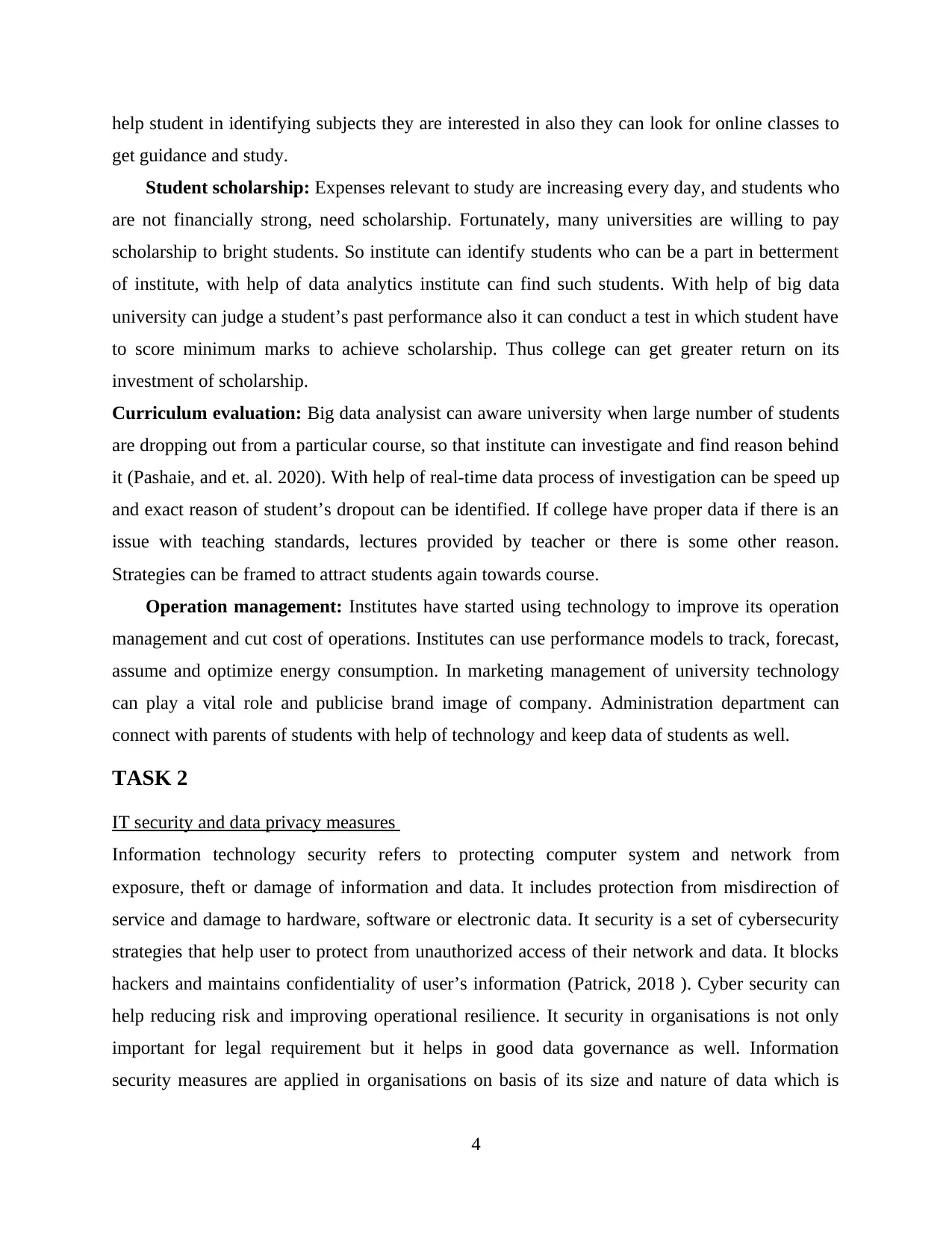
help student in identifying subjects they are interested in also they can look for online classes to
get guidance and study.
Student scholarship: Expenses relevant to study are increasing every day, and students who
are not financially strong, need scholarship. Fortunately, many universities are willing to pay
scholarship to bright students. So institute can identify students who can be a part in betterment
of institute, with help of data analytics institute can find such students. With help of big data
university can judge a student’s past performance also it can conduct a test in which student have
to score minimum marks to achieve scholarship. Thus college can get greater return on its
investment of scholarship.
Curriculum evaluation: Big data analysist can aware university when large number of students
are dropping out from a particular course, so that institute can investigate and find reason behind
it (Pashaie, and et. al. 2020). With help of real-time data process of investigation can be speed up
and exact reason of student’s dropout can be identified. If college have proper data if there is an
issue with teaching standards, lectures provided by teacher or there is some other reason.
Strategies can be framed to attract students again towards course.
Operation management: Institutes have started using technology to improve its operation
management and cut cost of operations. Institutes can use performance models to track, forecast,
assume and optimize energy consumption. In marketing management of university technology
can play a vital role and publicise brand image of company. Administration department can
connect with parents of students with help of technology and keep data of students as well.
TASK 2
IT security and data privacy measures
Information technology security refers to protecting computer system and network from
exposure, theft or damage of information and data. It includes protection from misdirection of
service and damage to hardware, software or electronic data. It security is a set of cybersecurity
strategies that help user to protect from unauthorized access of their network and data. It blocks
hackers and maintains confidentiality of user’s information (Patrick, 2018 ). Cyber security can
help reducing risk and improving operational resilience. It security in organisations is not only
important for legal requirement but it helps in good data governance as well. Information
security measures are applied in organisations on basis of its size and nature of data which is
4
get guidance and study.
Student scholarship: Expenses relevant to study are increasing every day, and students who
are not financially strong, need scholarship. Fortunately, many universities are willing to pay
scholarship to bright students. So institute can identify students who can be a part in betterment
of institute, with help of data analytics institute can find such students. With help of big data
university can judge a student’s past performance also it can conduct a test in which student have
to score minimum marks to achieve scholarship. Thus college can get greater return on its
investment of scholarship.
Curriculum evaluation: Big data analysist can aware university when large number of students
are dropping out from a particular course, so that institute can investigate and find reason behind
it (Pashaie, and et. al. 2020). With help of real-time data process of investigation can be speed up
and exact reason of student’s dropout can be identified. If college have proper data if there is an
issue with teaching standards, lectures provided by teacher or there is some other reason.
Strategies can be framed to attract students again towards course.
Operation management: Institutes have started using technology to improve its operation
management and cut cost of operations. Institutes can use performance models to track, forecast,
assume and optimize energy consumption. In marketing management of university technology
can play a vital role and publicise brand image of company. Administration department can
connect with parents of students with help of technology and keep data of students as well.
TASK 2
IT security and data privacy measures
Information technology security refers to protecting computer system and network from
exposure, theft or damage of information and data. It includes protection from misdirection of
service and damage to hardware, software or electronic data. It security is a set of cybersecurity
strategies that help user to protect from unauthorized access of their network and data. It blocks
hackers and maintains confidentiality of user’s information (Patrick, 2018 ). Cyber security can
help reducing risk and improving operational resilience. It security in organisations is not only
important for legal requirement but it helps in good data governance as well. Information
security measures are applied in organisations on basis of its size and nature of data which is
4
⊘ This is a preview!⊘
Do you want full access?
Subscribe today to unlock all pages.

Trusted by 1+ million students worldwide
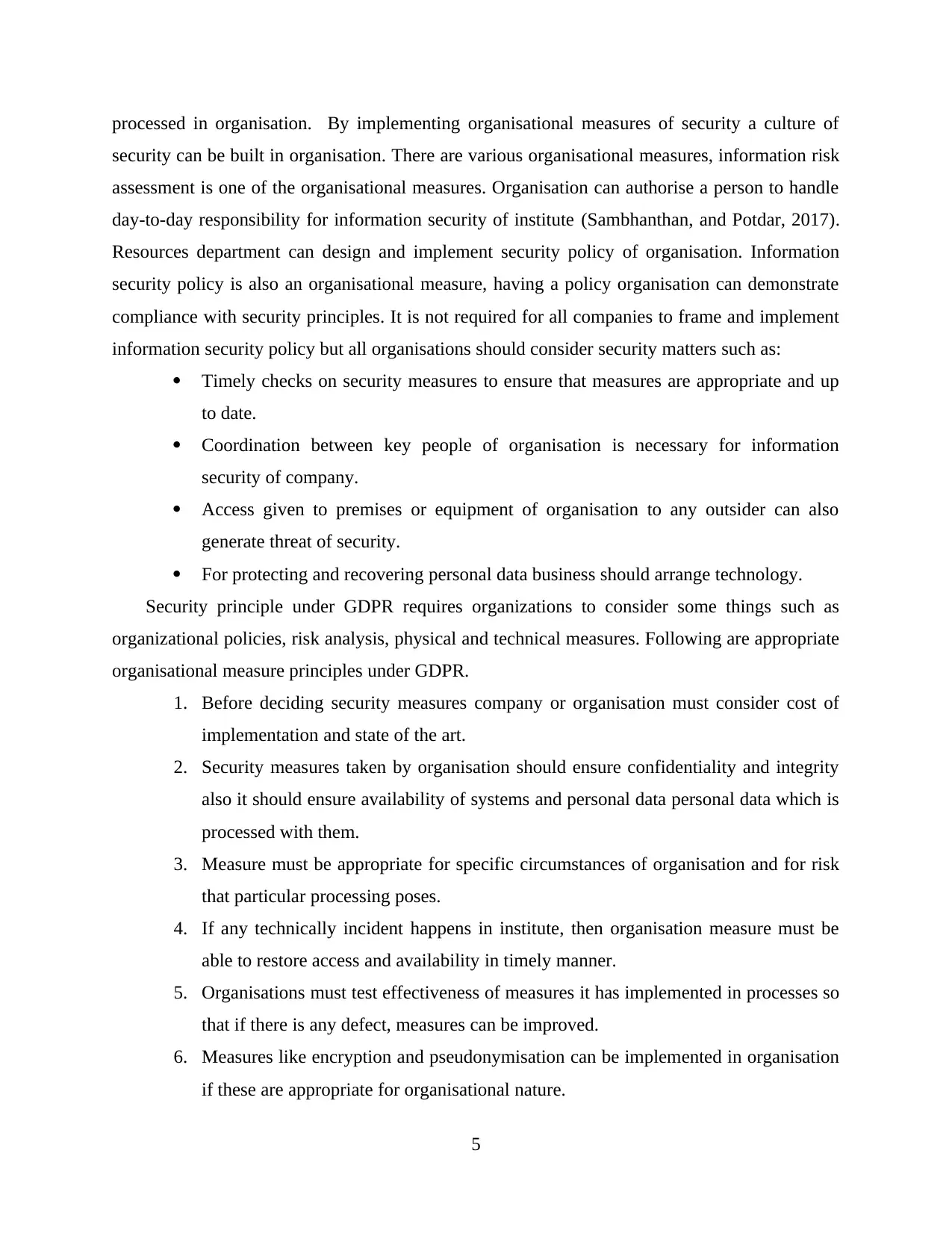
processed in organisation. By implementing organisational measures of security a culture of
security can be built in organisation. There are various organisational measures, information risk
assessment is one of the organisational measures. Organisation can authorise a person to handle
day-to-day responsibility for information security of institute (Sambhanthan, and Potdar, 2017).
Resources department can design and implement security policy of organisation. Information
security policy is also an organisational measure, having a policy organisation can demonstrate
compliance with security principles. It is not required for all companies to frame and implement
information security policy but all organisations should consider security matters such as:
Timely checks on security measures to ensure that measures are appropriate and up
to date.
Coordination between key people of organisation is necessary for information
security of company.
Access given to premises or equipment of organisation to any outsider can also
generate threat of security.
For protecting and recovering personal data business should arrange technology.
Security principle under GDPR requires organizations to consider some things such as
organizational policies, risk analysis, physical and technical measures. Following are appropriate
organisational measure principles under GDPR.
1. Before deciding security measures company or organisation must consider cost of
implementation and state of the art.
2. Security measures taken by organisation should ensure confidentiality and integrity
also it should ensure availability of systems and personal data personal data which is
processed with them.
3. Measure must be appropriate for specific circumstances of organisation and for risk
that particular processing poses.
4. If any technically incident happens in institute, then organisation measure must be
able to restore access and availability in timely manner.
5. Organisations must test effectiveness of measures it has implemented in processes so
that if there is any defect, measures can be improved.
6. Measures like encryption and pseudonymisation can be implemented in organisation
if these are appropriate for organisational nature.
5
security can be built in organisation. There are various organisational measures, information risk
assessment is one of the organisational measures. Organisation can authorise a person to handle
day-to-day responsibility for information security of institute (Sambhanthan, and Potdar, 2017).
Resources department can design and implement security policy of organisation. Information
security policy is also an organisational measure, having a policy organisation can demonstrate
compliance with security principles. It is not required for all companies to frame and implement
information security policy but all organisations should consider security matters such as:
Timely checks on security measures to ensure that measures are appropriate and up
to date.
Coordination between key people of organisation is necessary for information
security of company.
Access given to premises or equipment of organisation to any outsider can also
generate threat of security.
For protecting and recovering personal data business should arrange technology.
Security principle under GDPR requires organizations to consider some things such as
organizational policies, risk analysis, physical and technical measures. Following are appropriate
organisational measure principles under GDPR.
1. Before deciding security measures company or organisation must consider cost of
implementation and state of the art.
2. Security measures taken by organisation should ensure confidentiality and integrity
also it should ensure availability of systems and personal data personal data which is
processed with them.
3. Measure must be appropriate for specific circumstances of organisation and for risk
that particular processing poses.
4. If any technically incident happens in institute, then organisation measure must be
able to restore access and availability in timely manner.
5. Organisations must test effectiveness of measures it has implemented in processes so
that if there is any defect, measures can be improved.
6. Measures like encryption and pseudonymisation can be implemented in organisation
if these are appropriate for organisational nature.
5
Paraphrase This Document
Need a fresh take? Get an instant paraphrase of this document with our AI Paraphraser
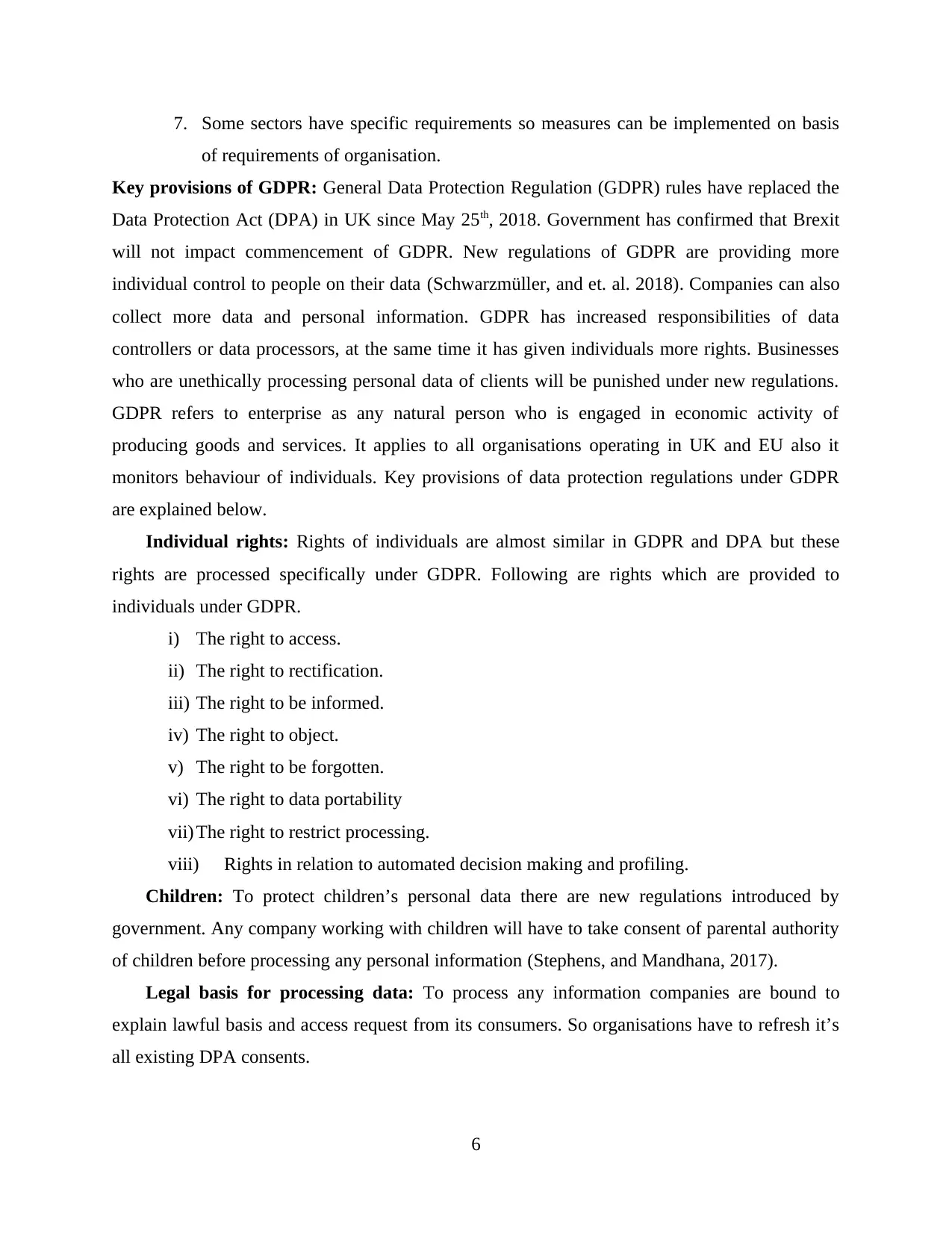
7. Some sectors have specific requirements so measures can be implemented on basis
of requirements of organisation.
Key provisions of GDPR: General Data Protection Regulation (GDPR) rules have replaced the
Data Protection Act (DPA) in UK since May 25th, 2018. Government has confirmed that Brexit
will not impact commencement of GDPR. New regulations of GDPR are providing more
individual control to people on their data (Schwarzmüller, and et. al. 2018). Companies can also
collect more data and personal information. GDPR has increased responsibilities of data
controllers or data processors, at the same time it has given individuals more rights. Businesses
who are unethically processing personal data of clients will be punished under new regulations.
GDPR refers to enterprise as any natural person who is engaged in economic activity of
producing goods and services. It applies to all organisations operating in UK and EU also it
monitors behaviour of individuals. Key provisions of data protection regulations under GDPR
are explained below.
Individual rights: Rights of individuals are almost similar in GDPR and DPA but these
rights are processed specifically under GDPR. Following are rights which are provided to
individuals under GDPR.
i) The right to access.
ii) The right to rectification.
iii) The right to be informed.
iv) The right to object.
v) The right to be forgotten.
vi) The right to data portability
vii) The right to restrict processing.
viii) Rights in relation to automated decision making and profiling.
Children: To protect children’s personal data there are new regulations introduced by
government. Any company working with children will have to take consent of parental authority
of children before processing any personal information (Stephens, and Mandhana, 2017).
Legal basis for processing data: To process any information companies are bound to
explain lawful basis and access request from its consumers. So organisations have to refresh it’s
all existing DPA consents.
6
of requirements of organisation.
Key provisions of GDPR: General Data Protection Regulation (GDPR) rules have replaced the
Data Protection Act (DPA) in UK since May 25th, 2018. Government has confirmed that Brexit
will not impact commencement of GDPR. New regulations of GDPR are providing more
individual control to people on their data (Schwarzmüller, and et. al. 2018). Companies can also
collect more data and personal information. GDPR has increased responsibilities of data
controllers or data processors, at the same time it has given individuals more rights. Businesses
who are unethically processing personal data of clients will be punished under new regulations.
GDPR refers to enterprise as any natural person who is engaged in economic activity of
producing goods and services. It applies to all organisations operating in UK and EU also it
monitors behaviour of individuals. Key provisions of data protection regulations under GDPR
are explained below.
Individual rights: Rights of individuals are almost similar in GDPR and DPA but these
rights are processed specifically under GDPR. Following are rights which are provided to
individuals under GDPR.
i) The right to access.
ii) The right to rectification.
iii) The right to be informed.
iv) The right to object.
v) The right to be forgotten.
vi) The right to data portability
vii) The right to restrict processing.
viii) Rights in relation to automated decision making and profiling.
Children: To protect children’s personal data there are new regulations introduced by
government. Any company working with children will have to take consent of parental authority
of children before processing any personal information (Stephens, and Mandhana, 2017).
Legal basis for processing data: To process any information companies are bound to
explain lawful basis and access request from its consumers. So organisations have to refresh it’s
all existing DPA consents.
6
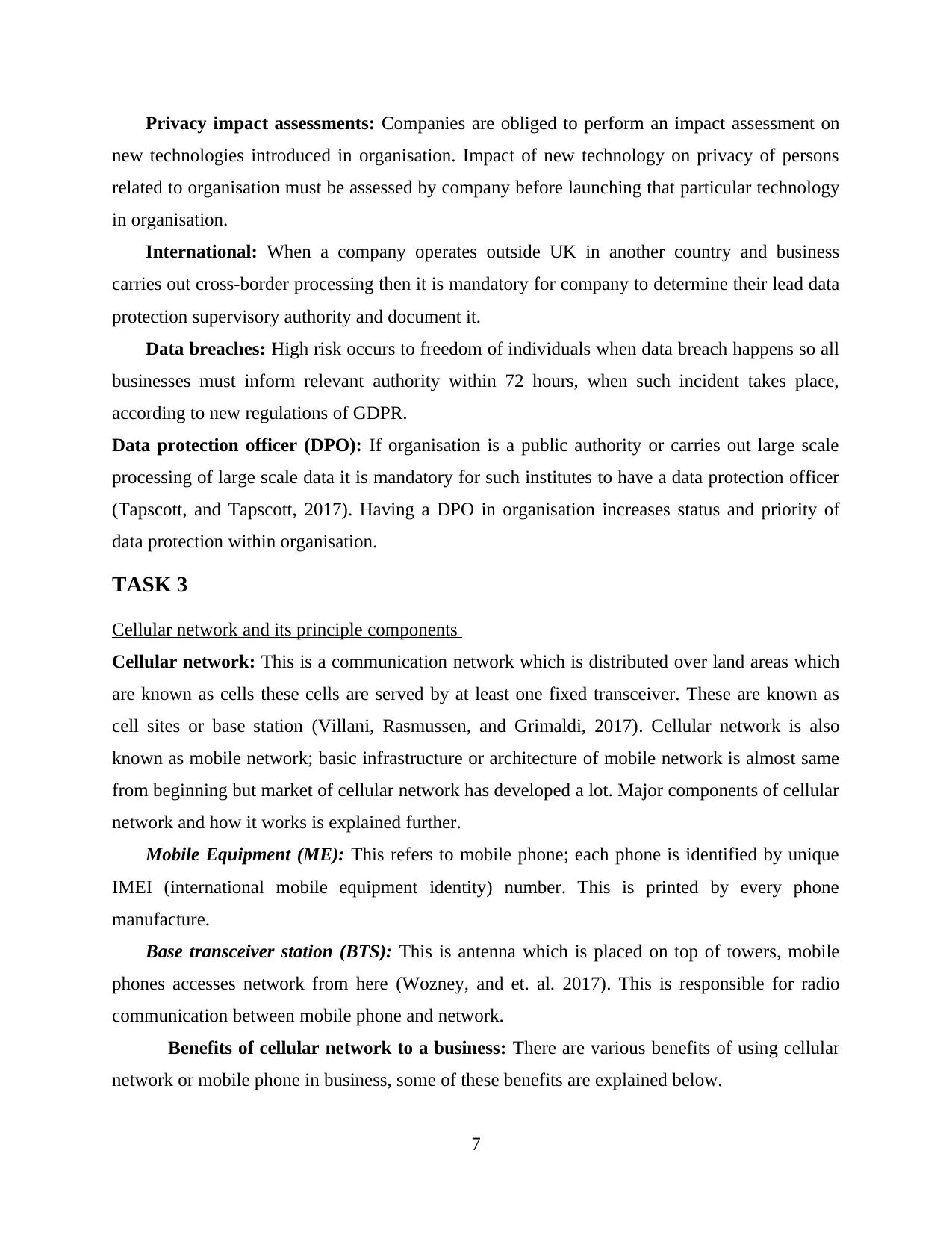
Privacy impact assessments: Companies are obliged to perform an impact assessment on
new technologies introduced in organisation. Impact of new technology on privacy of persons
related to organisation must be assessed by company before launching that particular technology
in organisation.
International: When a company operates outside UK in another country and business
carries out cross-border processing then it is mandatory for company to determine their lead data
protection supervisory authority and document it.
Data breaches: High risk occurs to freedom of individuals when data breach happens so all
businesses must inform relevant authority within 72 hours, when such incident takes place,
according to new regulations of GDPR.
Data protection officer (DPO): If organisation is a public authority or carries out large scale
processing of large scale data it is mandatory for such institutes to have a data protection officer
(Tapscott, and Tapscott, 2017). Having a DPO in organisation increases status and priority of
data protection within organisation.
TASK 3
Cellular network and its principle components
Cellular network: This is a communication network which is distributed over land areas which
are known as cells these cells are served by at least one fixed transceiver. These are known as
cell sites or base station (Villani, Rasmussen, and Grimaldi, 2017). Cellular network is also
known as mobile network; basic infrastructure or architecture of mobile network is almost same
from beginning but market of cellular network has developed a lot. Major components of cellular
network and how it works is explained further.
Mobile Equipment (ME): This refers to mobile phone; each phone is identified by unique
IMEI (international mobile equipment identity) number. This is printed by every phone
manufacture.
Base transceiver station (BTS): This is antenna which is placed on top of towers, mobile
phones accesses network from here (Wozney, and et. al. 2017). This is responsible for radio
communication between mobile phone and network.
Benefits of cellular network to a business: There are various benefits of using cellular
network or mobile phone in business, some of these benefits are explained below.
7
new technologies introduced in organisation. Impact of new technology on privacy of persons
related to organisation must be assessed by company before launching that particular technology
in organisation.
International: When a company operates outside UK in another country and business
carries out cross-border processing then it is mandatory for company to determine their lead data
protection supervisory authority and document it.
Data breaches: High risk occurs to freedom of individuals when data breach happens so all
businesses must inform relevant authority within 72 hours, when such incident takes place,
according to new regulations of GDPR.
Data protection officer (DPO): If organisation is a public authority or carries out large scale
processing of large scale data it is mandatory for such institutes to have a data protection officer
(Tapscott, and Tapscott, 2017). Having a DPO in organisation increases status and priority of
data protection within organisation.
TASK 3
Cellular network and its principle components
Cellular network: This is a communication network which is distributed over land areas which
are known as cells these cells are served by at least one fixed transceiver. These are known as
cell sites or base station (Villani, Rasmussen, and Grimaldi, 2017). Cellular network is also
known as mobile network; basic infrastructure or architecture of mobile network is almost same
from beginning but market of cellular network has developed a lot. Major components of cellular
network and how it works is explained further.
Mobile Equipment (ME): This refers to mobile phone; each phone is identified by unique
IMEI (international mobile equipment identity) number. This is printed by every phone
manufacture.
Base transceiver station (BTS): This is antenna which is placed on top of towers, mobile
phones accesses network from here (Wozney, and et. al. 2017). This is responsible for radio
communication between mobile phone and network.
Benefits of cellular network to a business: There are various benefits of using cellular
network or mobile phone in business, some of these benefits are explained below.
7
⊘ This is a preview!⊘
Do you want full access?
Subscribe today to unlock all pages.

Trusted by 1+ million students worldwide
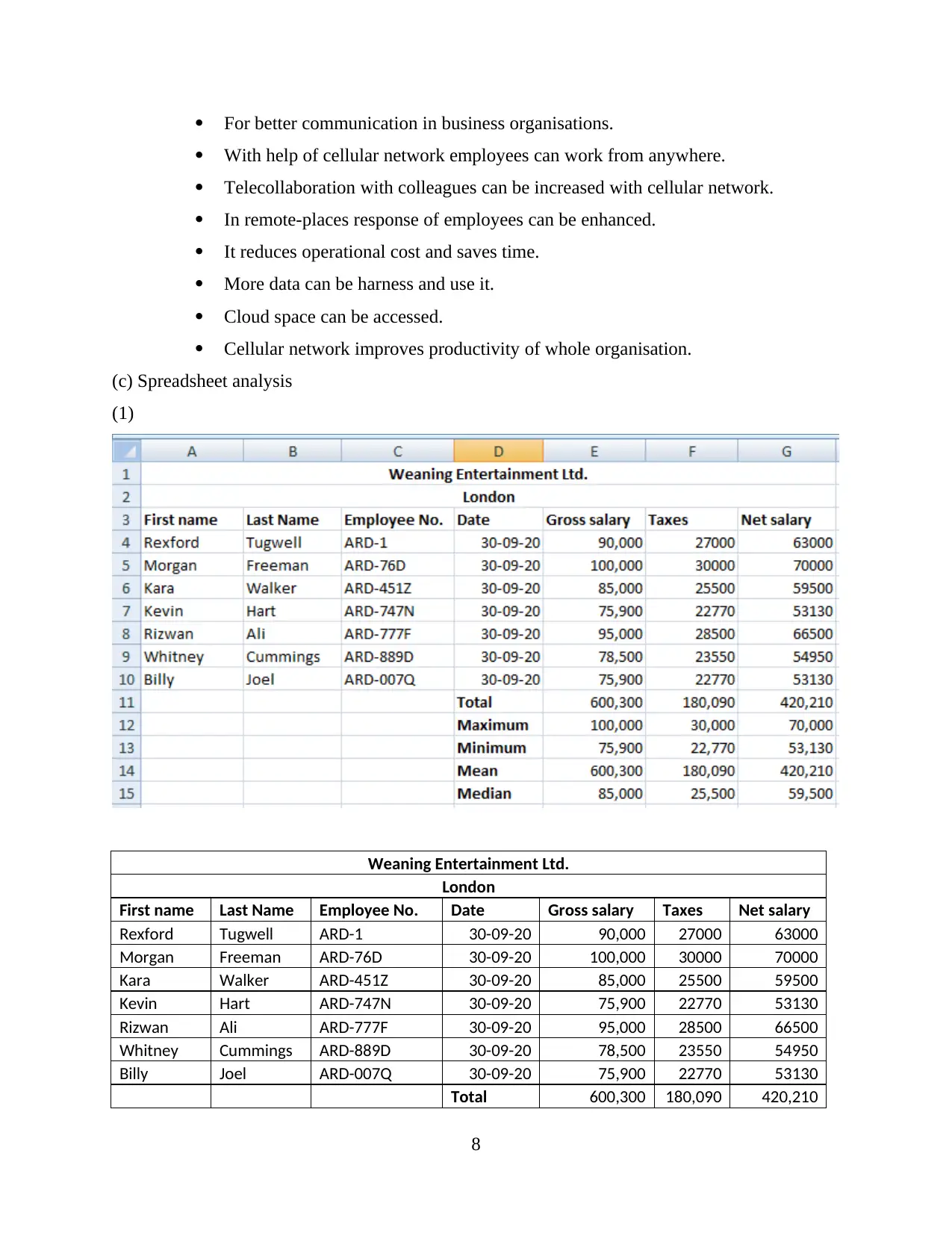
For better communication in business organisations.
With help of cellular network employees can work from anywhere.
Telecollaboration with colleagues can be increased with cellular network.
In remote-places response of employees can be enhanced.
It reduces operational cost and saves time.
More data can be harness and use it.
Cloud space can be accessed.
Cellular network improves productivity of whole organisation.
(c) Spreadsheet analysis
(1)
Weaning Entertainment Ltd.
London
First name Last Name Employee No. Date Gross salary Taxes Net salary
Rexford Tugwell ARD-1 30-09-20 90,000 27000 63000
Morgan Freeman ARD-76D 30-09-20 100,000 30000 70000
Kara Walker ARD-451Z 30-09-20 85,000 25500 59500
Kevin Hart ARD-747N 30-09-20 75,900 22770 53130
Rizwan Ali ARD-777F 30-09-20 95,000 28500 66500
Whitney Cummings ARD-889D 30-09-20 78,500 23550 54950
Billy Joel ARD-007Q 30-09-20 75,900 22770 53130
Total 600,300 180,090 420,210
8
With help of cellular network employees can work from anywhere.
Telecollaboration with colleagues can be increased with cellular network.
In remote-places response of employees can be enhanced.
It reduces operational cost and saves time.
More data can be harness and use it.
Cloud space can be accessed.
Cellular network improves productivity of whole organisation.
(c) Spreadsheet analysis
(1)
Weaning Entertainment Ltd.
London
First name Last Name Employee No. Date Gross salary Taxes Net salary
Rexford Tugwell ARD-1 30-09-20 90,000 27000 63000
Morgan Freeman ARD-76D 30-09-20 100,000 30000 70000
Kara Walker ARD-451Z 30-09-20 85,000 25500 59500
Kevin Hart ARD-747N 30-09-20 75,900 22770 53130
Rizwan Ali ARD-777F 30-09-20 95,000 28500 66500
Whitney Cummings ARD-889D 30-09-20 78,500 23550 54950
Billy Joel ARD-007Q 30-09-20 75,900 22770 53130
Total 600,300 180,090 420,210
8
Paraphrase This Document
Need a fresh take? Get an instant paraphrase of this document with our AI Paraphraser
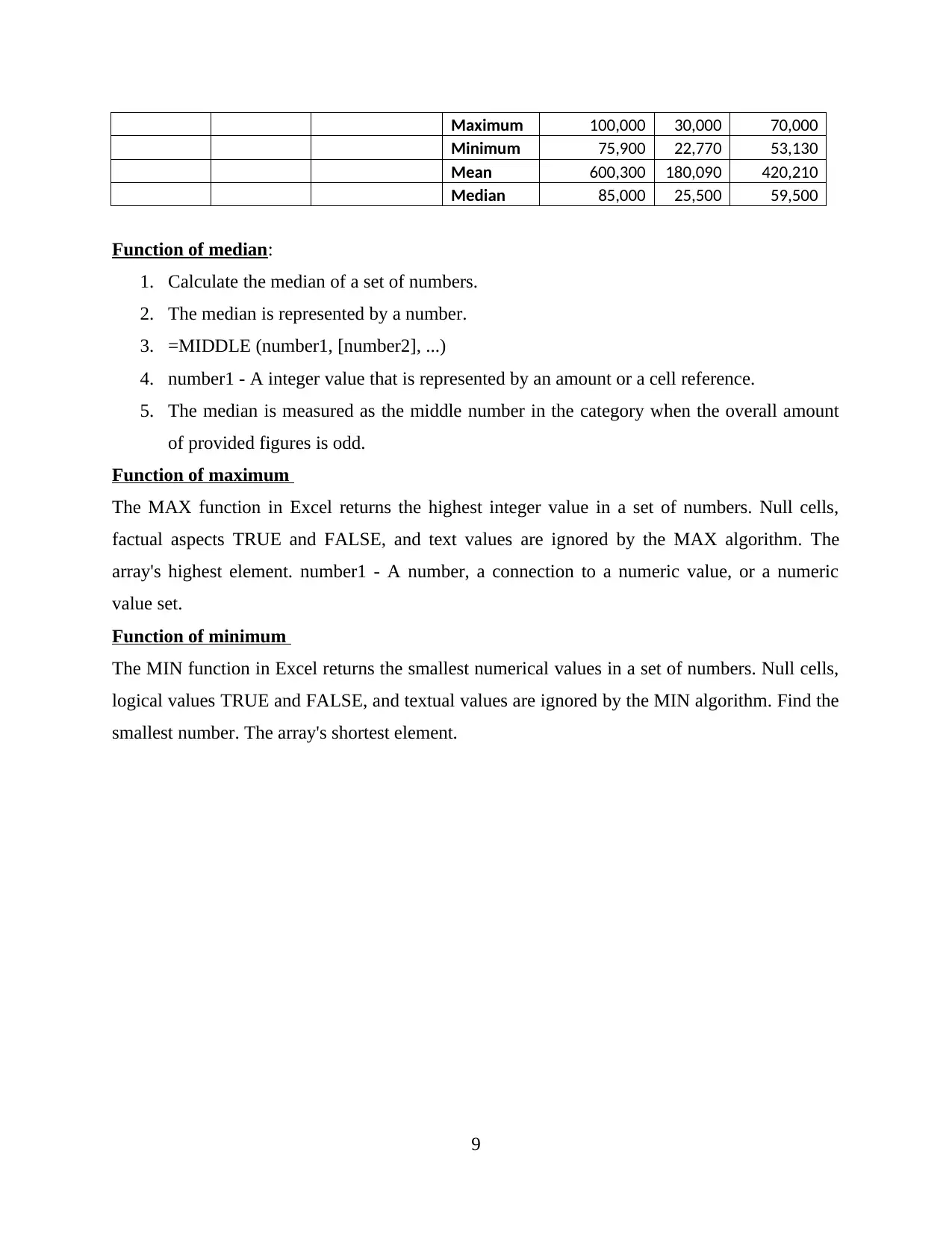
Maximum 100,000 30,000 70,000
Minimum 75,900 22,770 53,130
Mean 600,300 180,090 420,210
Median 85,000 25,500 59,500
Function of median:
1. Calculate the median of a set of numbers.
2. The median is represented by a number.
3. =MIDDLE (number1, [number2], ...)
4. number1 - A integer value that is represented by an amount or a cell reference.
5. The median is measured as the middle number in the category when the overall amount
of provided figures is odd.
Function of maximum
The MAX function in Excel returns the highest integer value in a set of numbers. Null cells,
factual aspects TRUE and FALSE, and text values are ignored by the MAX algorithm. The
array's highest element. number1 - A number, a connection to a numeric value, or a numeric
value set.
Function of minimum
The MIN function in Excel returns the smallest numerical values in a set of numbers. Null cells,
logical values TRUE and FALSE, and textual values are ignored by the MIN algorithm. Find the
smallest number. The array's shortest element.
9
Minimum 75,900 22,770 53,130
Mean 600,300 180,090 420,210
Median 85,000 25,500 59,500
Function of median:
1. Calculate the median of a set of numbers.
2. The median is represented by a number.
3. =MIDDLE (number1, [number2], ...)
4. number1 - A integer value that is represented by an amount or a cell reference.
5. The median is measured as the middle number in the category when the overall amount
of provided figures is odd.
Function of maximum
The MAX function in Excel returns the highest integer value in a set of numbers. Null cells,
factual aspects TRUE and FALSE, and text values are ignored by the MAX algorithm. The
array's highest element. number1 - A number, a connection to a numeric value, or a numeric
value set.
Function of minimum
The MIN function in Excel returns the smallest numerical values in a set of numbers. Null cells,
logical values TRUE and FALSE, and textual values are ignored by the MIN algorithm. Find the
smallest number. The array's shortest element.
9
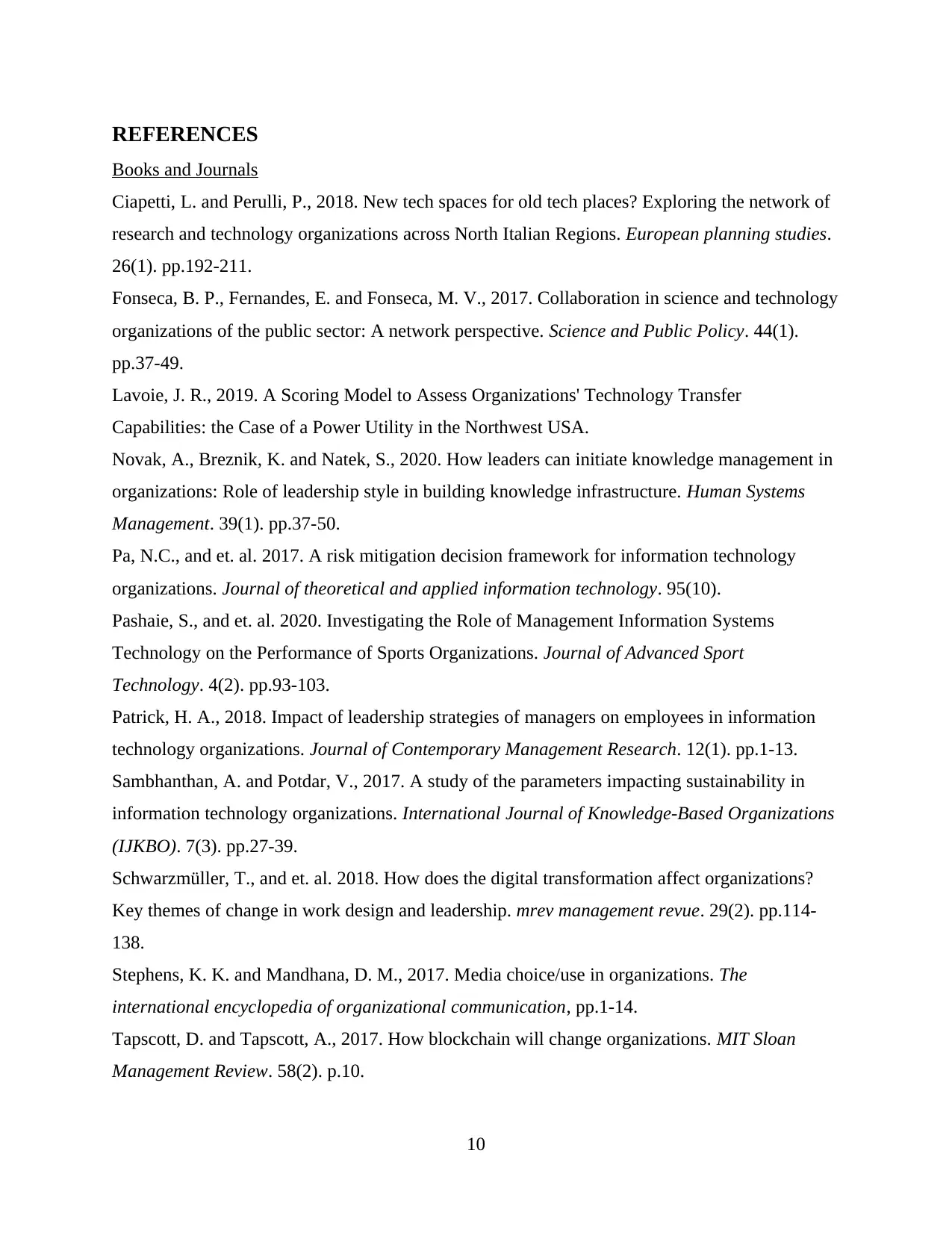
REFERENCES
Books and Journals
Ciapetti, L. and Perulli, P., 2018. New tech spaces for old tech places? Exploring the network of
research and technology organizations across North Italian Regions. European planning studies.
26(1). pp.192-211.
Fonseca, B. P., Fernandes, E. and Fonseca, M. V., 2017. Collaboration in science and technology
organizations of the public sector: A network perspective. Science and Public Policy. 44(1).
pp.37-49.
Lavoie, J. R., 2019. A Scoring Model to Assess Organizations' Technology Transfer
Capabilities: the Case of a Power Utility in the Northwest USA.
Novak, A., Breznik, K. and Natek, S., 2020. How leaders can initiate knowledge management in
organizations: Role of leadership style in building knowledge infrastructure. Human Systems
Management. 39(1). pp.37-50.
Pa, N.C., and et. al. 2017. A risk mitigation decision framework for information technology
organizations. Journal of theoretical and applied information technology. 95(10).
Pashaie, S., and et. al. 2020. Investigating the Role of Management Information Systems
Technology on the Performance of Sports Organizations. Journal of Advanced Sport
Technology. 4(2). pp.93-103.
Patrick, H. A., 2018. Impact of leadership strategies of managers on employees in information
technology organizations. Journal of Contemporary Management Research. 12(1). pp.1-13.
Sambhanthan, A. and Potdar, V., 2017. A study of the parameters impacting sustainability in
information technology organizations. International Journal of Knowledge-Based Organizations
(IJKBO). 7(3). pp.27-39.
Schwarzmüller, T., and et. al. 2018. How does the digital transformation affect organizations?
Key themes of change in work design and leadership. mrev management revue. 29(2). pp.114-
138.
Stephens, K. K. and Mandhana, D. M., 2017. Media choice/use in organizations. The
international encyclopedia of organizational communication, pp.1-14.
Tapscott, D. and Tapscott, A., 2017. How blockchain will change organizations. MIT Sloan
Management Review. 58(2). p.10.
10
Books and Journals
Ciapetti, L. and Perulli, P., 2018. New tech spaces for old tech places? Exploring the network of
research and technology organizations across North Italian Regions. European planning studies.
26(1). pp.192-211.
Fonseca, B. P., Fernandes, E. and Fonseca, M. V., 2017. Collaboration in science and technology
organizations of the public sector: A network perspective. Science and Public Policy. 44(1).
pp.37-49.
Lavoie, J. R., 2019. A Scoring Model to Assess Organizations' Technology Transfer
Capabilities: the Case of a Power Utility in the Northwest USA.
Novak, A., Breznik, K. and Natek, S., 2020. How leaders can initiate knowledge management in
organizations: Role of leadership style in building knowledge infrastructure. Human Systems
Management. 39(1). pp.37-50.
Pa, N.C., and et. al. 2017. A risk mitigation decision framework for information technology
organizations. Journal of theoretical and applied information technology. 95(10).
Pashaie, S., and et. al. 2020. Investigating the Role of Management Information Systems
Technology on the Performance of Sports Organizations. Journal of Advanced Sport
Technology. 4(2). pp.93-103.
Patrick, H. A., 2018. Impact of leadership strategies of managers on employees in information
technology organizations. Journal of Contemporary Management Research. 12(1). pp.1-13.
Sambhanthan, A. and Potdar, V., 2017. A study of the parameters impacting sustainability in
information technology organizations. International Journal of Knowledge-Based Organizations
(IJKBO). 7(3). pp.27-39.
Schwarzmüller, T., and et. al. 2018. How does the digital transformation affect organizations?
Key themes of change in work design and leadership. mrev management revue. 29(2). pp.114-
138.
Stephens, K. K. and Mandhana, D. M., 2017. Media choice/use in organizations. The
international encyclopedia of organizational communication, pp.1-14.
Tapscott, D. and Tapscott, A., 2017. How blockchain will change organizations. MIT Sloan
Management Review. 58(2). p.10.
10
⊘ This is a preview!⊘
Do you want full access?
Subscribe today to unlock all pages.

Trusted by 1+ million students worldwide
1 out of 13
Related Documents
Your All-in-One AI-Powered Toolkit for Academic Success.
+13062052269
info@desklib.com
Available 24*7 on WhatsApp / Email
![[object Object]](/_next/static/media/star-bottom.7253800d.svg)
Unlock your academic potential
Copyright © 2020–2025 A2Z Services. All Rights Reserved. Developed and managed by ZUCOL.





